How to choose a water meter and install it correctly: learning to count and save
The installation of individual or communal devices for monitoring water consumption cannot be called a negative factor at all.Using a water meter can be a plus. A useful meter will help to significantly reduce the number of utility payments.
And for this you need to know all the details about the water meter: how to choose it and win. We will tell you which water meter is best to install, describe the specifics of the operation of different devices, and also provide useful and practical tips for reducing water consumption.
The content of the article:
How to Find the Best Water Meter
A water meter is a small measuring device that records the volume of water passing through a water supply system for a specific unit of time. It measures water in cubic meters received by the consumer per hour or minute - m³.
The scope of application is wide: from household and municipal spheres to various industries. Accordingly, with a wide range of applications, they also differ in size, design and type of action.
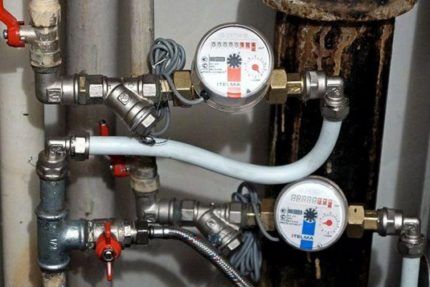
The market offers a wide range of meters of various types from domestic or foreign manufacturers.
According to their type, water meters are divided into the following types:
- Tachometer. The principle of operation is based on placing a flow-distributing impeller or turbine in the aquatic environment, which is connected to a counting mechanism.
- Electromagnetic. Their counting mechanism is based on the ability of a magnetic field to record the speed of movement of the medium passing through the pipeline. Electromagnetic meters are used mainly in industry.
- Ultrasonic. The basis for measuring the volume of water is the analysis of the acoustic effect of ultrasound transmitted to the medium passing through the pipes.
- Vortex. To take measurements, a body of a given shape is placed in the fluid flow. The device reads the frequency of vortices arising on the body washed by the jet during the passage of the medium. The result is proportional to the flow rate.
- Volumetric. This group of counters measures the number of revolutions of a rotating chamber having a constant volume.
Of the entire group of water meters, only tachometer and electronic ones are intended for household use, so let’s look at their review in more detail.
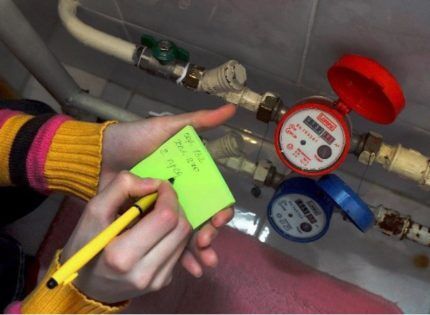
Specifics of tachometer counters
Tachometer counters are attractive due to their elementary structure and operating principle that is similar in complexity. Their main structural parts are an impeller or turbine, according to which devices in this category are divided into impeller and turbine types.
Water passing through the meter acts on the turbine blades or impeller, which are mechanically connected to the metering device. The counting mechanism simply converts the number of revolutions recorded by it into liters or cubic meters of water.
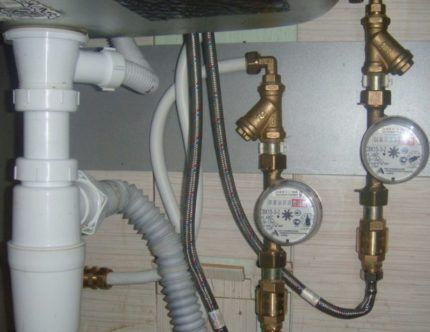
The family of vane devices includes multi-jet and single-jet varieties. Turbine meters, in turn, are divided into devices with a mechanical and an induction signal reading system. Both tachometer types are further classified according to the location of the counting element into “dry” and “wet”.
A tachometer counter is a reliable purchase. Its service life is at least 12 years, it makes relatively accurate measurements, and is inexpensive.
The operation of simple devices has been tested over dozens of almost flawless years of operation in centralized water supply systems. That is why they are still in high demand for installation in private and public utilities.

Private owners most often purchase vane water meters for apartments. Their diameter is suitable for traditional pipelines - 40 mm, and for turbine ones it is from 50 to 100 mm. That’s why they are chosen by utility workers and owners of mansions connected to the water supply main.
The maximum volume of water, calculated by the impeller wheel, is only 15 cubic meters per hour. Turbine engines have much wider capabilities in this regard, which again affects the choice of the optimal device and range of application.
Water meters also differ in the type of installation: those that can be installed vertically and those that can be installed horizontally, as well as universal devices that can be mounted in absolutely any position.
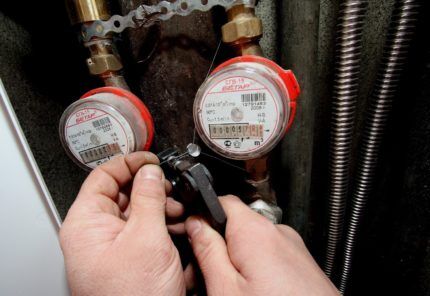
The classification into “wet” and “dry” type is based on the principle of location of the counting mechanism. In the first case, it is not separated from the water in any way. It is technically simple, which means the price is low. However, when operating in a heavily polluted environment, a “wet” meter suffers from distortion of measurements.
In “dry” type meters, the counting mechanism is protected from water by a special non-magnetic partition. Thanks to this, deposits do not accumulate on the walls and working parts of the device. They become dirty much more slowly, and therefore their service life is noticeably longer than that of wet-type meters. The price is also significantly higher.
Let us recall the division of tachometer instruments into single- and multi-jet. When the latter operates, the water flowing through the impeller is divided into several jets. Due to this, the flow turbulence error is significantly reduced.
This means that a more accurate accounting of the volume of water is carried out. That is why multi-jet devices are more expensive than single-jet devices.
Let's look at tachometer water quantity meters, which are most in demand among owners of private houses and apartments, below.
Single jet water meter
The single-jet counting device belongs to the category of dry vessels. It changes the number of revolutions of the impeller under the influence of one flow of water.After information about the rotation of the impellers is transmitted to the reading device through magnetic couplings. The measuring element is separated from the water, due to which it lasts much longer.
Its advantages include a design that is protected from the action of a magnetic field and provides the counting mechanism with the ability to perform the most accurate measurements.
A significant advantage is the possibility of additionally equipping all devices with pulse outputs. With this equipment, read the meter readings remotely.
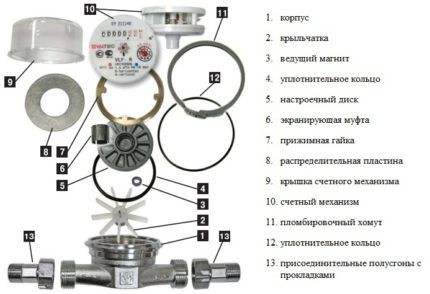
Characteristics of multi-jet meters
Multi-jet differ from the type described above by dividing the water flow into several jets. The device that breaks the flow into jets is located in front of the impeller. These design features help reduce turbulence, which affects measurement error.
The advantages of multi-jet devices are ease of installation. Dismantling for next execution water meter verification done with the same ease. To do this, it is enough to separate the upper, easily removable component from the device.
They are supplied with adapter sleeves that allow the device to be installed flush with the decorative surface. They can also be equipped with pulse outputs for reading meter readings from a distance.
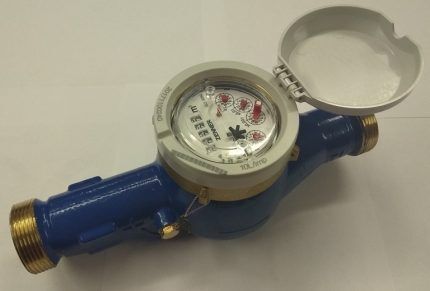
Valve type of devices
The operating principle of the valve device is similar to those listed above. It belongs to the category of dry ships.But there is a useful improvement in its design - the ability to install a water valve inside the device has been introduced, thanks to which you can immediately turn off the water. This design feature formed the basis of the name.
The valve meter is easy to install. A significant plus is that the front indicator part of the meter can be rotated 360°. In addition, you can rotate in three dimensions, which makes it easier to read the data. It can also be equipped with a pulse output.
Combined water meters
Their design includes both a vane meter and a turbine meter, located on a parallel branch. The advantage of the combination is that when the water pressure is low, it passes through the vane meter.
When the pressure increases and the vane meter can no longer cope, its valve closes and water flows through the turbine apparatus. In current models of combined devices, both the impeller and turbine working body are located in the same plane.
Special meters for hot water
The volume of hot water supplied is measured by conventional vane and turbine varieties. They have similar sizes and designs, only materials that are resistant to high temperatures are used in production.
Let us note that, in accordance with technical standards, a higher error in the readings of hot water meters is allowed than for analogues for cold water.
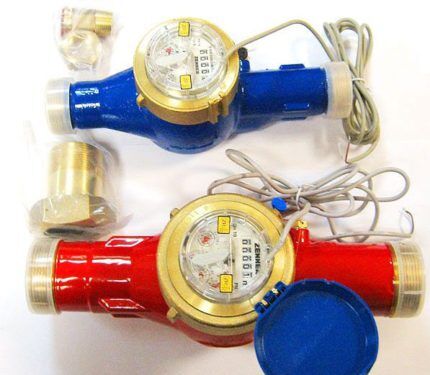
Features of electronic meters
According to the operating principle, electronic meters are conventional vane or turbine meters.But their design has been modernized with very useful devices that read the actual water temperature.
It is recommended to install them where the temperature of hot water reaching the water supply points to the consumer does not correspond to the norm.
It happens that in the end, barely warm water is supplied, which is considered hot according to the tariff.
Unlike standard meters, which take into account only volume, electronic meters provide clear information about how many cubic meters of water were consumed at exactly the temperature specified by GOST and which the housing and communal organization undertakes to provide.
Electronic measuring instruments are equipped with a temperature sensor system. While water flows that does not meet the hot category standards, the electronic meter perceives it as cold and displays the readings in the summation unit.
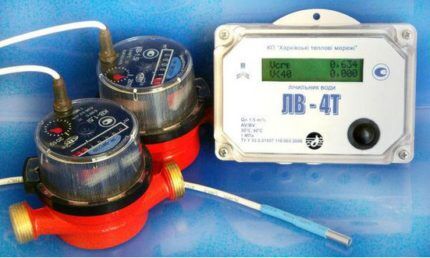
The following temperature sensor only takes into account water that can be classified as “warmed”. And now the last sensor detects hot water. True, some electronic meters have only two devices for recording hot and cold water temperature limits.
All data about how much water was consumed and what temperature is entered into the summing block. However, all the information that is shown in the adder only shows the amount of water consumed, and you will have to convert it into a monetary equivalent yourself.
Advantages of an electronic meter:
- Opportunity pay water bills not only depending on the volume of water, but also on its temperature.
- Installing a meter display anywhere, not just near pipes.
- The electronic meter does not depend on voltage surges, as it operates on an autonomous power supply.
The electronic meter is powered by a lithium battery. It is enough for the entire period of use of the device. The battery cannot be recharged. And one more thing: it is forbidden to short-circuit it.
Which water meter is better to install?
First you need to decide what water temperature the device should calculate. If you want to know the exact volume of water at standard temperature, then installing an electronic meter will be the ultimate solution.
For those who are not interested in the difference in the actual amount of water at standard temperature, conventional tachometer devices designed to operate in a hot environment are suitable.
If you need a meter for cold water, then installing a mechanical meter would be quite advisable, but the same electronic one provides more accurate information about water consumption in this case.
The most accurate information will be provided by multi-jet vane variants and turbine ones with an induction reading device. “Dry” instruments will last much longer than “wet” ones and will provide readings with less error.
Naturally, more accurate, modernized systems are more expensive than simple representatives, but simple-minded species have more admirers due to their affordability.
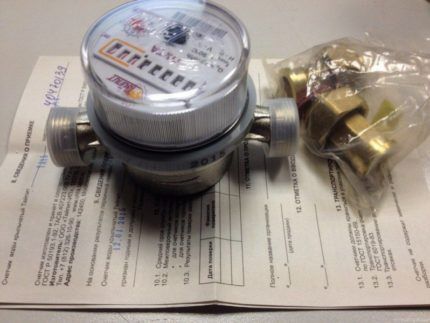
However, there is another important side to deciding which water meter will be better and more profitable to install. Vane devices are suitable for installation in pipelines with a diameter of up to 40 mm. Turbine varieties are used for measurement if the pipe Ø is 40 mm or more.
If you have any questions about choosing a water meter, read the article - Types of water meters: overview of different types + recommendations for buyers
How to count water correctly?
You need to practice how to correctly count water using your own meter. You should find out the total volume of water consumption for the month. To do this, you need the latest readings for the same calendar period before last. You will find them on the receipt with the bills presented for payment of the apartment. This figure must be included in the account.
To accurately find out the water consumption for the past month, you need to subtract the value of the previous month from the data now taken from the device. If you have just installed water meters, then the previous indicators will be zero.
Modern water meters have a scale of 8 digits. The first five of them will be black, and the last three will be red.
Pay attention only to the values of the black numbers; they show the amount of hot or cold water wasted. There is no need to remember the red indicators and they are not included in the receipt; they indicate the total level of water consumption in liters.
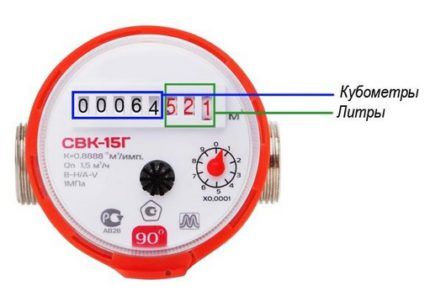
At the end of the month it is necessary take readings from the water meter. Information from it can be submitted to the water utility in writing or by sending an electronic file to the company’s website via the Internet.
How to save water using a meter?
When the meter is successfully installed and put into operation, it becomes possible to identify and eliminate sources of overconsumption. This is especially true for families with low incomes.
And if we take into account the constant rise in tariffs, the question of how to save water using the meter becomes pressing.
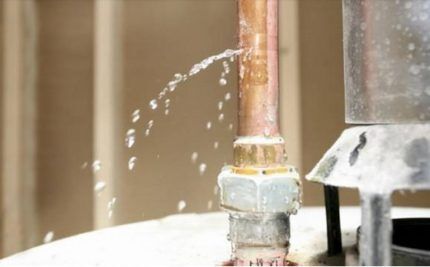
Below we will look at absolutely legal methods of saving water without harming hygiene or compromising overall living comfort.
Task #1 - checking for leaks
After the meter is installed, attention should be paid to the condition of all main pipes and devices. Usually we “can’t get our hands on” various household little things, like leaks, which almost always exist in every home.
We often think that we can turn a blind eye to this. And a minimal amount of water flows away, and our financial losses can only be calculated in tens of kopecks.
But in reality, everything is not so rosy, since according to statistics, with a faulty drain tank, 65,000 liters of water go to waste in a year, and with a leaking tap, a fabulous 75,000 liters of water per year are lost.
Also, do not forget about leaking pipe joints. And if we sum everything up, then a rather impressive amount comes out per year, which simply disappears. It seems that the leaks are minimal, but “it can be filled drop by drop.”
Challenge #2 – Use the Right Faucets
It would be more advisable to use lever mixers instead of conventional valves.Their advantage is that the water shuts off instantly, unlike a valve. And if you consider that we open the tap many times a day, then in the end we will be able to save a significant amount of money.
Task #3 - fix the toilet
The problem is not only that the toilet may simply leak. There are separate types of them with two options for drain operation: conventional and economical. The latter will provide an economic effect of about 25 liters of water per day. Over the course of a year, this turns out to be about 7,500 liters, which, you agree, is quite good.
Of course, a significant overconsumption of water is observed when the plumbing is faulty - it is necessary to promptly fix a toilet leak.
Challenge #4 – Use a Shower Instead of a Bath
The benefits of showering are obvious to any reader, especially to those who indulge in water procedures several times a day. This approach will help you really save not only money, but also personal time.
As for the means, in 5 minutes of taking a shower, approximately 80 liters of water will be consumed, which is not enough to fill even half a standard-sized bath. This method of saving water will help you save up to 1,700 rubles per year.
As an additional tip, we can suggest that you buy shower heads with thin holes, which significantly reduces the flow rate per minute.
There are also shower heads with aerators on the market that mix water with air. In addition to the pleasant massage effect, they also consume two or even three times less water without reducing efficiency. It is advisable to select aerator for faucets in the kitchen and bathroom.
Task #4 - install a water heater
Installation heating equipment can significantly reduce hot water costs.Why take it from the hot water supply when you can heat it yourself. To understand how feasible this is, you just need to calculate the costs of electricity and heated water.
Compare them with the costs of hot water supplied from a centralized network. The winning will clearly not be on the side of the latter. We also recommend heating the water after 10 pm or early in the morning, when electricity rates are lower.
Challenge #5 – Think Lean
We brush our teeth two or more times every day. Usually during the hygiene procedure, when brushing and paste is being processed, the tap remains open. It will not be superfluous to close the tap during this period, and open it only when necessary.
It sounds funny, of course, but when you calculate the water consumption due to such a trifle, it becomes not funny at all.
It is important to approach the dishwashing process correctly. The tap usually consumes 5 liters of water per minute and is open no matter what we are doing at the time.
You should also open it when necessary and do not apply too much detergent to the dishes, because In order to wash it off, a lot of water is also consumed. A good way to save on washing dishes is to buy a dishwashing machine.
If you need to wash food, then wash it in a container rather than under an open tap, this will also save you a significant amount of money per year. And one “large” wash of clothes will be much more economical than several “small” ones.
When the choice of the meter is made, it is necessary to install it. Detailed information about installing a water meter is presented in the articles:
- Procedure and rules for installing water meters: how to properly install and seal them
- How to install water meters yourself: installation and connection diagram for a typical meter
Conclusions and useful video on the topic
Video with a detailed description of the installation process of water meters:
Video reading algorithm carried out by the measuring device:
How to reduce hot water supply costs:
We have provided fundamental methods for saving water. They may probably seem too insignificant, but these little things do not require any effort from you at all, and can save your budget significantly. Paired with a well-chosen water meter, they will help reduce utility costs.
Do you have anything to add or have questions about choosing a water meter? Please leave comments on the publication and share your secrets of economical water consumption. The contact form is located in the lower block.
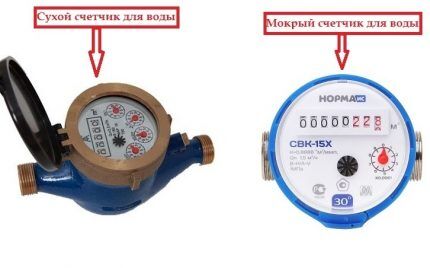

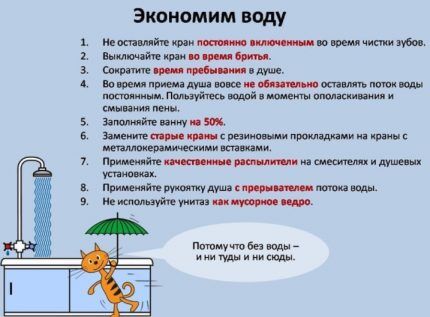




I lived without meters for a long time, then I got tired of actually paying for what I rarely use. I dug through a bunch of information on the Internet and literally became a guru on this topic, as much as possible for a woman who is far from such issues in normal times. Finally bought it. Electronic, expensive. Exactly what I wanted and found it to be the best.
I called a plumber from the management company. Which during the installation process successfully broke one counter... Of course, I understand everything - they apparently install several popular models/types. And he later returned the money to me for the device... But it’s such a shame for the lack of professionalism of those who should understand this topic... In the end, I returned the meters (except for the broken one) and bought cheap ones, mechanical ones. But this weirdo with the letter M never reimbursed the money.
The time has come to check the hot water meter, so I went to see what would happen if this was not done. It turned out that we would have to pay according to the standard, which is 2.4 cubic meters per person. In July, we saved a lot of water; the two of us poured out 5.5 cubic meters. In winter it takes 8-10, also saving money.
Maybe the fact is that we only have very hot water in the evening, the rest of the time it’s 45 degrees, some machine in the basement decides that. That is, it is beneficial for us to live without a meter, even taking into account the increasing coefficient. Most people don't have them at their entrances.
Worked for almost 20 years at the Center for Standardization, Metrology and Certification. During various tests, Betar water meters performed best. I installed these at home too. The devices operate with almost perfect accuracy, plus they are protected by anti-magnetic seals. If handled properly they will last for a very good period of time.
Maybe the Betar water meters themselves are not bad, but they too often have defective products. Moreover, before in the 2000s, I didn’t hear anything bad about them, but in the last 10 years, several of my acquaintances broke down without completing their six-year sentence.
In my opinion, you have slightly confused “wet” with “dry”. Please clarify the information and captions under the pictures.
I had Betar for the first time. Within 2 years, all 4 failed. Then the plumber recommended Norma. She worked for two years. Today there is one meter on the hot water pipe. I'm looking for new options. But in general, what can we say: they cannot make reliable meters in a country with a backward economy. Look at the same Soviet electricity meters. They are eternal.And the ones they were forced to replace with both fail and overcharge.